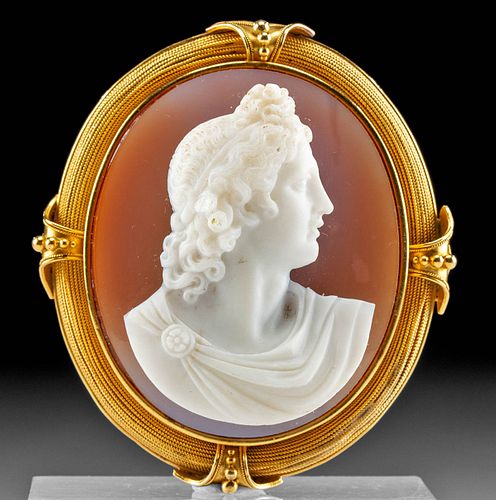18th C. Neoclassical Gold Brooch w/ Agate Cameo of Apollo
Lot 64
About Seller
Artemis Fine Arts
686 S Taylor Ave, Ste 106
Louisville, CO 80027
United States
Selling antiquities, ancient and ethnographic art online since 1993, Artemis Gallery specializes in Classical Antiquities (Egyptian, Greek, Roman, Near Eastern), Asian, Pre-Columbian, African / Tribal / Oceanographic art. Our extensive inventory includes pottery, stone, metal, wood, glass and textil...Read more
Categories
Estimate:
$6,000 - $8,000
Absentee vs Live bid
Two ways to bid:
- Leave a max absentee bid and the platform will bid on your behalf up to your maximum bid during the live auction.
- Bid live during the auction and your bids will be submitted real-time to the auctioneer.
Bid Increments
| Price | Bid Increment |
|---|---|
| $0 | $25 |
| $300 | $50 |
| $1,000 | $100 |
| $2,000 | $250 |
| $5,000 | $500 |
| $10,000 | $1,000 |
| $20,000 | $2,500 |
| $50,000 | $5,000 |
| $100,000 | $10,000 |
| $200,000 | $20,000 |
About Auction
By Artemis Fine Arts
Mar 24, 2022
Set Reminder
2022-03-24 10:00:00
2022-03-24 10:00:00
America/New_York
Bidsquare
Bidsquare : Exceptional Antiquities Ethnographic Fine Art
https://www.bidsquare.com/auctions/artemis-gallery/exceptional-antiquities-ethnographic-fine-art-9057
Museum-worthy examples of classical antiquities (Egyptian, Greek, Roman, Near Eastern), Viking, Far East / Asian, Pre-Columbian, African / Tribal, Oceanic, Native American, Spanish Colonial, Fossils, Ancient Jewelry, Fine / Visual Arts, so much more! Artemis Fine Arts info@artemisgallery.com
Museum-worthy examples of classical antiquities (Egyptian, Greek, Roman, Near Eastern), Viking, Far East / Asian, Pre-Columbian, African / Tribal, Oceanic, Native American, Spanish Colonial, Fossils, Ancient Jewelry, Fine / Visual Arts, so much more! Artemis Fine Arts info@artemisgallery.com
- Lot Description
Northern Europe, Neoclassical, ca. 18th to 19th century CE. Inscribed "103 / Rignani" on verso. A gorgeous agate cameo of Apollo, the Greek and Roman god of archery, music, dance, truth, healing, light, and poetry, set in a lovely gold cameo. Epitomizing the beau ideal, the youthful deity looks right displaying a muscular build with generously lidded eyes, a noble nose, and gently parted lips. A thick coiffure of luscious locks crowns his head, boasting a bun at the top with sinuous coils meandering down the nape of his neck, nicely framing his masculine profile. His shoulders are draped by the billowing folds of a toga, held in place by a floral fibula on his right side. This elegant cameo is further embellished by a frame of incised gold wires, fastened in place by 4 equidistantly spaced, fin-shaped loops. A suspension loop on the verso suggests that the cameo was previously hung for display. Size (brooch): 1.9" W x 2.3" H (4.8 cm x 5.8 cm); (cameo): 1.6" W x 1.8" H (4.1 cm x 4.6 cm); gold quality: 85% (equivalent to 20K+); weight: 47.6 grams
This gorgeous cameo is inspired by the Apollo Belvedere dating to 325 BCE and attributed to Leochares - a Roman copy of which is located in the Vatican Museums, as the original has never been found. The Apollo Belvedere is one of the most revered works of antiquity. The sculpture captivated masters of the Renaissance such as Michelangelo and Durer as well as those of the Neoclassical period such as Antonio Canova. For example, one can see these influences in Michelangelo's David (1501-1504) and Canova's Perseus (1801). Both masters strove to realize Leochares' ability to capture an idealized rendering of Apollo. In addition to the statue in the Vatican Museums, one can also find sculptures, busts, and sketches that echo the Apollo Belvedere composition in some of the most prestigious museums of the world, including the Metropolitan Museum of Art, the Victoria and Albert Museum, the British Museum, and the Getty. Son of Zeus and Leto, and twin brother of the huntress Artemis, Apollo was known as the archer and the god of light, who harnessed his chariot and moved the Sun across the sky.
A similar cameo of Apollo that was carved by Antonio Angelo Amastini (Italian, 1754 to 1816) and served as the cover of a snuff box can be found in the Royal Collection under accession number 4259. Two more similar cameos of Apollo Belvedere are located at the British Museum under museum number 1978,1002.1065 and the Metropolitan Museum of art under accession number 40.20.55a-c (this one attributed to Luigi Saulini, Italian, 1819 to 1883).
This piece has been searched against the Art Loss Register database and has been cleared. The Art Loss Register maintains the world's largest database of stolen art, collectibles, and antiques.
Provenance: East Coast collection, New York Gallery, New York City, New York, USA, before 2010
All items legal to buy/sell under U.S. Statute covering cultural patrimony Code 2600, CHAPTER 14, and are guaranteed to be as described or your money back.
A Certificate of Authenticity will accompany all winning bids.
PLEASE NOTE: Due to recent increases of shipments being seized by Australian & German customs (even for items with pre-UNESCO provenance), we will no longer ship most antiquities and ancient Chinese art to Australia & Germany. For categories of items that are acceptable to ship to Australia or Germany, please contact us directly or work with your local customs brokerage firm.
Display stands not described as included/custom in the item description are for photography purposes only and will not be included with the item upon shipping.
#159446Inscribed "103 / Rignani" on verso. Loosening to 1 gold wire. Otherwise, intact, excellent, and wearable with nice preservation of detail. Collection label on verso.Condition
- Shipping Info
-
All shipping is handled in-house for your convenience. Your invoice from Artemis Gallery will include shipping calculation instructions. If in doubt, please inquire BEFORE bidding for estimated shipping costs for individual items.
-
- Buyer's Premium



 EUR
EUR CAD
CAD AUD
AUD GBP
GBP MXN
MXN HKD
HKD CNY
CNY MYR
MYR SEK
SEK SGD
SGD CHF
CHF THB
THB













